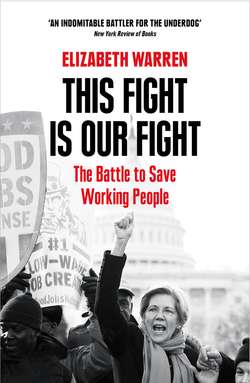Читать книгу This Fight is Our Fight: The Battle to Save Working People - Elizabeth Warren - Страница 20
TAKING THE FIGHT DIRECTLY TO THE POWERFUL
ОглавлениеThis history may seem like a dusty tale about a time long past, but the economic battles of the 1930s were as intense as any attack launched during the over-the-top 2016 political season. And these early economic battles had a transformative effect on our country. They set the stage for the development of our economy and our financial laws—and for nearly half a century of stunning prosperity.
Even as the economy slowly began improving, the corporate big shots whose powers were being challenged did not like the direction in which the country was headed. Newspaper titan William Randolph Hearst referred to FDR as “Stalin Delano Roosevelt” and insisted that his reporters substitute “Raw Deal” for “New Deal” in news articles that were published throughout the country. Millionaires warned about Roosevelt’s “socialist government.” Time magazine reported that, “with few exceptions, members of the so-called Upper Class frankly hate Franklin Roosevelt.” One member of that class said ominously, “What that fellow Roosevelt needs is a thirty-eight-caliber revolver right at the back of his head.”
My grandmother might have believed that Roosevelt made the country safe, but among the rich and powerful, deep resentment was growing over the changes Roosevelt had brought about. Battle lines were forming.
In June 1936, Roosevelt went to Philadelphia to accept the Democratic nomination for his second term. One hundred thousand people crowded into the University of Pennsylvania’s sports stadium, Franklin Field. The cheers were deafening as the president entered the arena in a limousine and rode a long loop around the field.
It must have been a gratifying moment for Roosevelt, but it’s also likely that he was thinking about an immediate challenge: he needed to get out of his car and onto the stage. In the fifteen years since he had been stricken with polio, Roosevelt found walking—and even standing—a painful and precarious business, and he always went to great pains to hide his paralysis from public view. Now the task would be more hazardous: it had been raining, and the stadium’s grass was slick.
As the president slowly made his way to the speaking podium while leaning on the arm of his son, people jostled for a better view and to shout their good wishes. The president was bumped. When his metal leg brace sprang open, he fell heavily. As he went down, the papers of his speech flew out into the crowd. On the ground, Roosevelt was pale and shaken, his clothes smudged with dirt.
After a shocked moment, his aides quickly pulled him to his feet. Most people in the stadium couldn’t see what had happened, but his aides were panicked. Roosevelt immediately pushed ahead.
“Clean me up,” he ordered.
Within minutes he was standing on the platform, enduring grinding pain and staring into the bright stadium lights at a crowd of a hundred thousand people. As the cheering built to a roar, he waved and smiled. And then he went on the attack. Roosevelt called out the “privileged princes” and “economic royalty” running corporate America. The crowd went wild as FDR declared war—not just “war against want and destitution and economic demoralization,” but “a war for the survival of democracy.”
Four months later, as his campaign moved into its final week, Roosevelt was still on the attack. On the Saturday before Election Day, he kept his sights trained on those moneyed interests, declaring, “They are unanimous in their hate for me—and I welcome their hatred.”
Three days after that, he was reelected, winning a majority in every state in the union except Maine and Vermont.
In Philadelphia, one hundred thousand people heard Roosevelt declare war on the country’s “economic royalty.”
